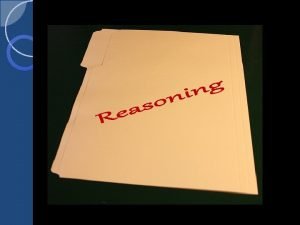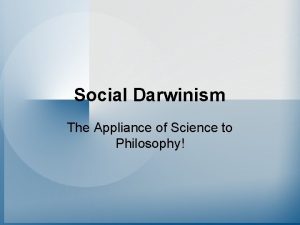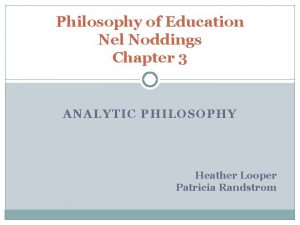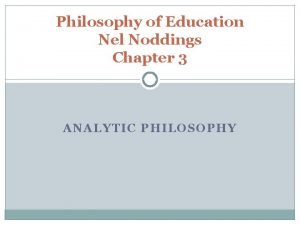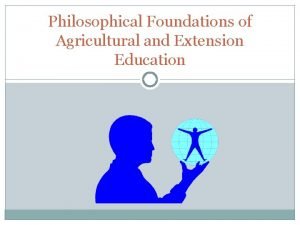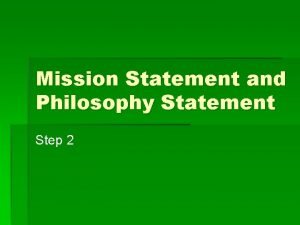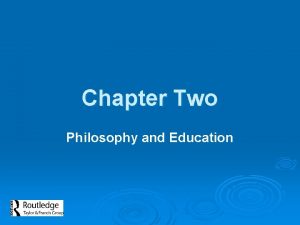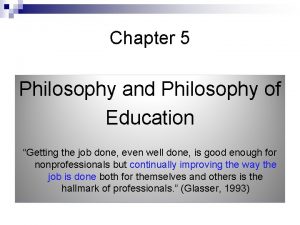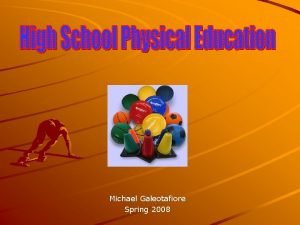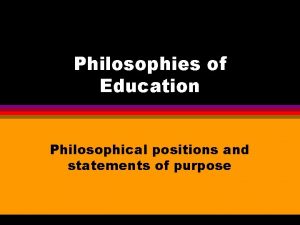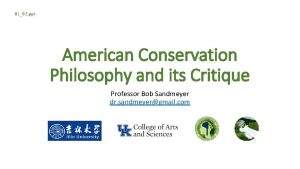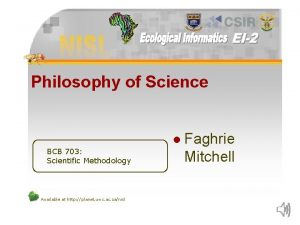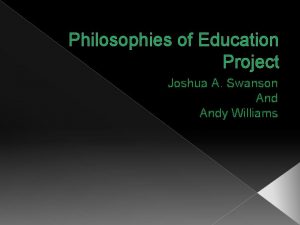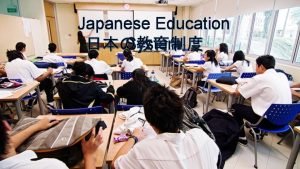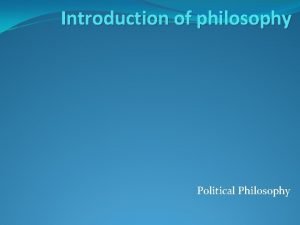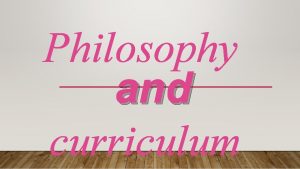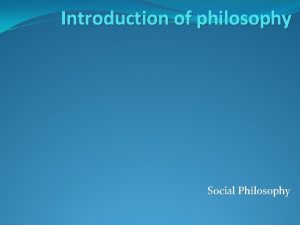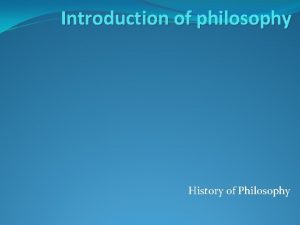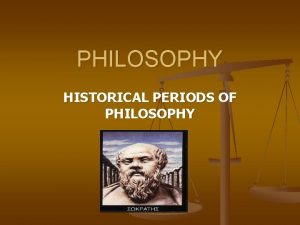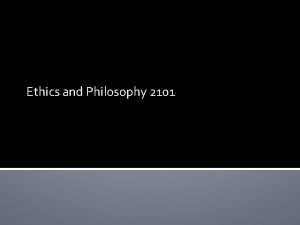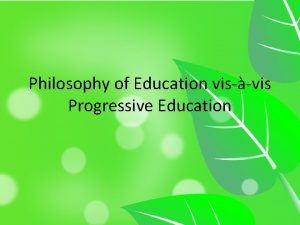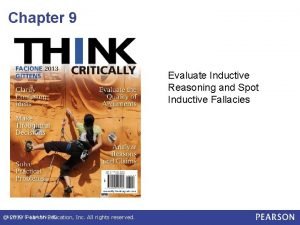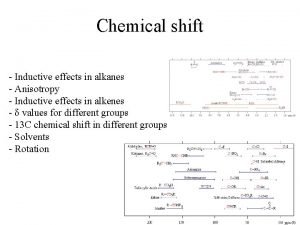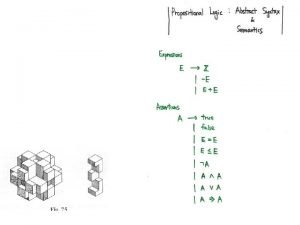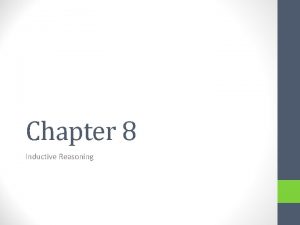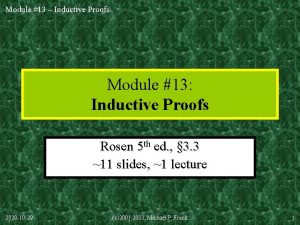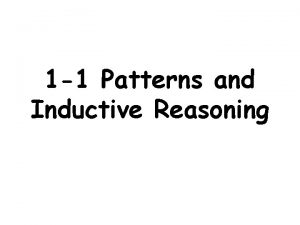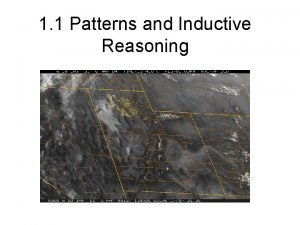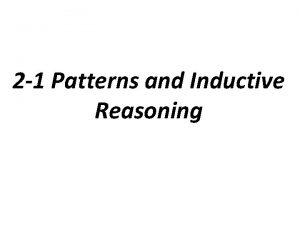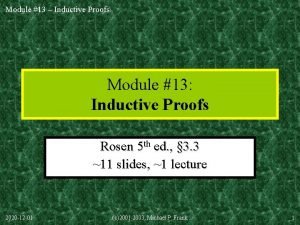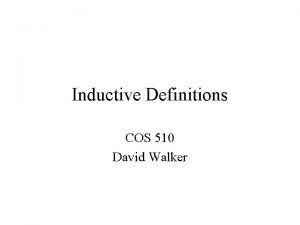Inductive Approach Education philosophy Inductive Approach Teacher uses



























- Slides: 27

Inductive Approach

Education philosophy Inductive Approach • Teacher uses different learning resources to let students conclude certain theory or rule from independent cases. • The teaching activities are designed to let students understand the properties and real cases of certain concepts through observation and experiences, students are allowed more opportunities to learn from the working process.

Roles of Teachers &Students Inductive Approach Role of Teachers • resources providers and leaders of activities • providing scaffoldings for guiding students to learn Role of students • active learners, participate in lesson activities with high degree of involvement

Role of IT Inductive Approach The role of IT in this approach are facilitative and enabling tools for the students its main function is to be the cognitive tool of students as well as tools that would enable teachers to monitor and evaluate students’ conceptual understandings and progress. This type of tool includes: 1. Knowledge-based intelligent tutoring systems 2. Drill and practice tools 3. Simulation tools 4. Modelling tools

Learning Process Inductive Approach 1. Teacher introduces the learning goals 2. Teacher provides related examples and questions, and scaffoldings for students to observe, describe and make comparisons, questioning in this stage is mainly in an open-ended format. 3. Teacher summarizes students’ responds , and guides students to discover rules and relationships based on existing experiences so as to achieve the teaching goals 4. Teacher asks students to apply the fresh learned concepts into inclass or take-home assignments.

Cases Inductive Approach Lesson Video Clips P 2 mathematics S 6 Geography S 6 Chemistry

P 2 mathematics Prisms and pyramids Teaching goal Learning outcomes Lesson outline Lesson Video clips Requirement of equipment and technology Your Reflection

Teaching goals Prisms and pyramids • Students are able to identify the characteristics of prisms and pyramids.

Learning outcomes • Prisms and pyramids students are able to state out the characteristics of prisms and pyramids • students are able to identify prisms and pyramids

Lesson outline Prisms and pyramids 1. motivation Teacher uses daily life examples to start the lesson. 2. Introduction of prisms and pyramids Teacher uses models to introduce the concept of prisms and pyramids and asks students to observe the characteristics. 3. Introduction of operation of the software Teacher demonstrates the operation of the software.

Lesson outline Prisms and pyramids 4. Students activity By using the software students explore the characteristics of prisms and pyramids. 5. Conclusion Teacher asks students to conclude the characteristics of prisms and pyramids.

Lesson Video Clips P 6 Prisms and pyramids

Requirement of equipment and technological competence P 6 Prisms and pyramids Venue: Computer Room Number of Students: 20 approximately Requirement of teachers’ technological competence: - Basic operation of computer Requirement of students’ technological competence: - Basic operation of computer Hardware: -20 computers for student usage -1 computer for teacher usage Software: Teaching software (Figure and Space) Peripheral: Projector

Your reflection P 6 Prisms and pyramids 1. What is the role of this teaching software? 2. What kinds of ability is enhanced by using this software? Would this software be an obstacle for students in learning this topic? 3. If you are going to teach this topic, what kinds of software you would like to have? 4. Do you consider the one to one ratio of student to computer an ideal resources arrangement in teaching?

S. 6 Geography Causes leading air pollution caused by urbanization Teaching goals Learning outcomes Lesson outline Lesson video Clips Requirement of equipment and technology Your reflection

S. 6 Geography Causes leading air pollution caused by urbanization Teaching objectives: To allow students understand the causes leading to air pollution caused by urbanization

Learning outcomes Secondary Six: Geography -Causes leading to air pollution caused by urbanization • Students are able to find out causes leading to air pollution cased by urbanization through discussion, observation and analysis

Lesson Outline Secondary Six: Geography Causes leading to air pollution caused by urbanization 1. Illustration of topic and narration of the goals of the lesson Teacher uses Power. Point to illustrate the topic, and introduces the content by questioning. Teacher then points out the goal of the lesson - using the GIS software to find out the causes of air pollution 2. Introduction of operation of the software Teacher demonstrates the operation of the software, and then let student have a try.

Lesson Outline Secondary Six: Geography Causes leading to air pollution caused by urbanization 3. Raising questions Teachers raises the questions for investigation, and let students observe the changes through the operating software, and to summarize the cases leading to air pollution caused by urbanization. 4. Student activities Students gets into groups of 4 to 5 to carry out the study.

Lesson Video Clips Secondary Six: Geography -Causes leading to air pollution caused by urbanization

Requirement of equipment and technological competence Secondary Six: Geography -Causes leading to air pollution caused by urbanization Venue: Computer Room Number of Students: 30 approximately Requirement of teachers’ technological competence: - Operation of Arc View GIS - Operation of Power. Point Requirement of students’ technological competence: - Operation of Arc View GIS Hardware: -20 computers for student usage -1 computer for teacher usage Software: Arc View GIS software Peripheral: Projector

Your reflection Secondary Six: Geography -Causes leading to air pollution caused by urbanization 1. What superiority has the GIS software brought about to the Geography teaching? 2. Besides being the illustration tool of the lesson, how can GIS software be utilized in teaching? 3. How can students’ learning be benefited by using computers to practise group teaching? 4. What are the difficulties for teachers using the GIS software? How can they cope with the challenges?

Secondary Six: Chemistry - Hybridization and Markovnikow’s rule Teaching Goals: To let students explore the changes of the bonding in the process of Hybridization and to apply the Markovnikow’s rule to solve problems related to the mechanism. Learning outcomes: Students are able to present the changes of the bonding in the Hybridization process and to use the Markovnikow’s rule to complete related online exercises.

Secondary Six: Chemistry - Hybridization and Markovnikow’s rule Learning Outline: Teacher ask students to observe and describe the chemical reaction of the animation, then the teacher explains the mechanism of the process. Teacher then uses animation again to be the introduction of the teaching of the Markovnikow’s rule, lastly the teacher asks student to complete the online related exercises.

Secondary Six: Chemistry - Hybridization and Markovnikow’s rule Venue: Computer Room Number of students: 30 approximately Requirement of Teachers’ Technological Competence: - Basic operation of computer Requirement of Students’ Technological Competence: - Basic operation of computer Requirement of equipment: - 30 computers for students’ usage - 1 computer for teacher’s usage - Power. Point - Projector

Lesson Video Clips Secondary Six: Chemistry - Hybridization and Markovnikow’s rule

Secondary Six: Chemistry - Hybridization and Markovnikow’s rule Your Reflection 1. What is the role of the Simulation Tool in teaching? 2. How to use the Simulation Tool to enhance the critical thinking ability of the students? 3. If you are to teach this topic, do you have other handling methods? 4. Do you consider the one to one ratio of student to computer an ideal resources arrangement in teaching?
 Mtep malaysia
Mtep malaysia Inductive method
Inductive method Deductive vs inductive
Deductive vs inductive Erf for teacher 3
Erf for teacher 3 Good afternoon my dear students
Good afternoon my dear students Herbert spencer social darwinism
Herbert spencer social darwinism Analytic philosophy in education
Analytic philosophy in education Nel noddings philosophy of education
Nel noddings philosophy of education State 4 philosophies of extension education
State 4 philosophies of extension education Physical education vision statement examples
Physical education vision statement examples Historical development of environmental education
Historical development of environmental education Postmodernism curriculum
Postmodernism curriculum 5 educational implications of philosophy
5 educational implications of philosophy Physical education of athens
Physical education of athens Schools of educational philosophy chapter 9
Schools of educational philosophy chapter 9 Hindu philosophy of education
Hindu philosophy of education Teaching philosophy
Teaching philosophy Allama iqbal poetry in english
Allama iqbal poetry in english Aapherd
Aapherd Theodore brameld philosophy of education
Theodore brameld philosophy of education Realism philosophy
Realism philosophy Perennialism in education
Perennialism in education Ant philosophy ppt
Ant philosophy ppt Rabindranath tagore profile in english
Rabindranath tagore profile in english What is philosophy
What is philosophy What is perennialism in philosophy of education
What is perennialism in philosophy of education Reconstructionism
Reconstructionism Philosophy of education in japan
Philosophy of education in japan


